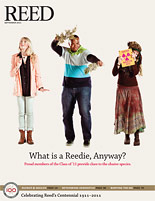
IRIS login | Reed College home Volume 90, No. 3: September 2011
Demographics out of Joint
The worries about the Reed student body being insufficiently diverse are motivated by many good desires for the college and for society as a whole. I agree with Joel Batterman ’10 [Letters, June 2011] that missing out on a variety of perspectives impoverishes the Reed community.
However, I question the use of the current racial and ethnic percentages as a good way to measure the college’s “success” at encouraging diversity. Tracing the percentages of those who fall into which particular category succeeds most notably not in celebrating diversity but in reinforcing categories that are deeply flawed, hopelessly undefined, and always already in a state of flux. As an institution that celebrates critical thinking and challenges common perceptions of the world, Reed should be undermining (or at the very least restructuring) these categories, not maintaining them. Why is the institution known for “thinking outside the box” perpetuating categories that have such hazy boundaries and such arbitrary distinctions, as if “race” really is an appropriate measurable quality? Separating people into “Hispanic, African American, and Asian” categories is hardly more sophisticated than the old neighborhood covenants designed to keep “Mongoloid, Asiatic, and Negroid” races out of the suburbs. Simply creating less offensive category titles in the name of progress does very little to address the fallacies of racial categorization in the first place.
Reed should be deconstructing and shattering these categories, not using them to chase some kind of percentaged ideal, as if students with particular backgrounds are meant to be landscape elements or pinches of spice. Sometimes the language of targeted recruitment sounds quite patronizing, hardly the tactic to invite people who are looking to transcend centuries of racism. I am reminded of a radical feminist adage from the 1970s, “You cannot break your chains by polishing them.”


LATEST COMMENTS
steve-jobs-1976 I knew Steve Jobs when he was on the second floor of Quincy. (Fall...
Utnapishtim - 2 weeks ago
Prof. Mason Drukman [political science 1964–70] This is gold, pure gold. God bless, Prof. Drukman.
puredog - 1 month ago
virginia-davis-1965 Such a good friend & compatriot in the day of Satyricon...
czarchasm - 4 months ago
John Peara Baba 1990 John died of a broken heart from losing his mom and then his...
kodachrome - 7 months ago
Carol Sawyer 1962 Who wrote this obit? I'm writing something about Carol Sawyer...
MsLaurie Pepper - 8 months ago
William W. Wissman MAT 1969 ...and THREE sisters. Sabra, the oldest, Mary, the middle, and...
riclf - 10 months ago